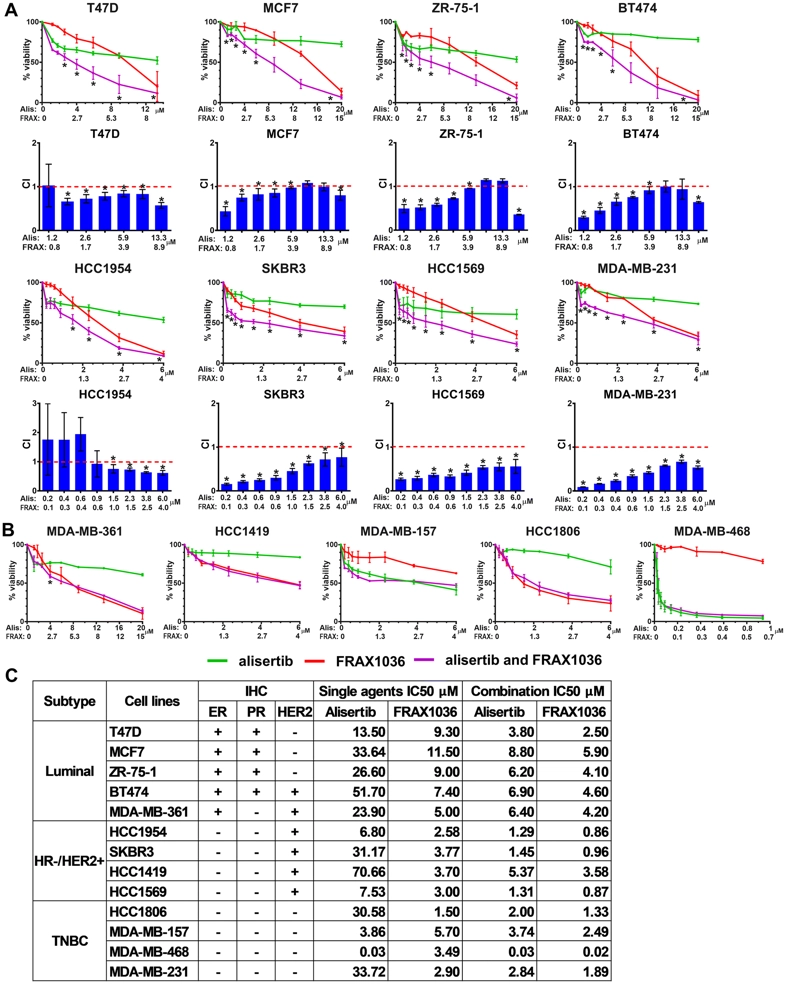Combined inhibition of Aurora A and p21-activated kinase 1 as a new treatment strategy in breast cancer

Purpose
The serine-threonine kinases Aurora A (AURKA) and p21-activated kinase 1 (PAK1) are frequently overexpressed in breast tumors, with overexpression promoting aggressive breast cancer phenotypes and poor clinical outcomes. Besides the well-defined roles of these proteins in control of cell division, proliferation, and invasion, both kinases support MAPK kinase pathway activation and can contribute to endocrine resistance by phosphorylating estrogen receptor alpha (ERα). PAK1 directly phosphorylates AURKA and its functional partners, suggesting potential value of inhibiting both kinases activity in tumors overexpressing PAK1 and/or AURKA. Here, for the first time, we evaluated the effect of combining the AURKA inhibitor alisertib and the PAK inhibitor FRAX1036 in preclinical models of breast cancer.
Methods
Combination of alisertib and FRAX1036 was evaluated in a panel of 13 human breast tumor cell lines and BT474 xenograft model, with assessment of the cell cycle by FACS, and signaling changes by immunohistochemistry and Western blot. Additionally, we performed in silico analysis to identify markers of response to alisertib and FRAX1036.
Results
Pharmacological inhibition of AURKA and PAK1 synergistically decreased survival of multiple tumor cell lines, showing particular effectiveness in luminal and HER2-enriched models, and inhibited growth and ERα-driven signaling in a BT474 xenograft model. In silico analysis suggested cell lines with dependence on AURKA are most likely to be sensitive to PAK1 inhibition.
Conclusion
Dual targeting of AURKA and PAK1 may be a promising therapeutic strategy for treatment of breast cancer, with a particular effectiveness in luminal and HER2-enriched tumor subtypes.
Publisher URL: http://link.springer.com/article/10.1007/s10549-019-05329-2
Open URL: https://link.springer.com/content/pdf/10.1007%2Fs10549-019-05329-2.pdf
DOI: 10.1007/s10549-019-05329-2
Keeping up-to-date with research can feel impossible, with papers being published faster than you'll ever be able to read them. That's where Researcher comes in: we're simplifying discovery and making important discussions happen. With over 19,000 sources, including peer-reviewed journals, preprints, blogs, universities, podcasts and Live events across 10 research areas, you'll never miss what's important to you. It's like social media, but better. Oh, and we should mention - it's free.
Researcher displays publicly available abstracts and doesn’t host any full article content. If the content is open access, we will direct clicks from the abstracts to the publisher website and display the PDF copy on our platform. Clicks to view the full text will be directed to the publisher website, where only users with subscriptions or access through their institution are able to view the full article.


